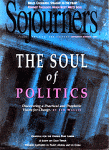An exceptionally articulate young man joined a new-members class in a Colorado congregation. He was completing a doctorate in English literature and was thrilled to discover that many of the tools of his study were useful in reading and studying the Bible and the tradition of his faith. He found his life among the lives of God’s faithful people and wanted to join the church.
He asked to meet with me alone. He told me that he was gay and preparing to come out. Could he be openly gay and be a member of that congregation? Would he be welcomed?
The answer to the first question was yes. He could be a full member in good standing; he could worship with the congregation. But I could give him little hope that the congregation would welcome him as a kindred member of the body of Christ. We were unable, as the people of God, to discuss issues of faith and human sexuality without anger, fear, and hate dominating the conversation.
That was a decade ago. Today more congregations are drawn into the discussion through members who are openly gay, by denominational statements and studies, and in everyday encounters in a society coming to terms with its diversity and its sexuality.
The book Caught in the Crossfire is presented as a tool to assist Christians in their discussions about homosexuality and faith by defining some general themes of the current debate, offering contrasting positions, and inviting persons of faith into the debate. Six of its eight chapters are devoted to particular themes, such as the role of scripture or the possibility of gay unions in the church. After writers present contrasting positions, the editors briefly summarize each chapter and provide a study guide to prompt discussion. The intent is to present an aid to dialogue in the context of a responsible theological framework.
Sally Geis and Donald Messer have authored a thoughtful book. The information is generally familiar to those involved in discussions on human sexuality and Christianity. The presentation, designed to draw congregational groups into constructive discussion, is most helpful. The writing and concepts are appropriate for use with groups of varied academic experience. The summaries are fair to both sides of the debate, so that neither need feel that it is being "set up," and the discussion questions are engaging.
The book is designed for use in group conversations and would be a useful tool for introducing the discussion in a congregation or faith community. A sound set of ground rules is suggested for use in group settings to provide some boundaries for healthy discussion. The book might be inflammatory, however, in settings where there is existing controversy. In cases where honest and open dialogue has decayed into factionalism, the open and varied tone of the discussion might be abused.
The essays on biblical applicability hinge on predictable differences in interpretation and definition with little fresh air. Neither ventured to suggest their basis for applying the Bible with integrity to the current debate.
Throughout the book, the tension is evident between those searching for biblical absolutes to shape their theology and those listening to social and cultural voices to inform theirs. The articles by James Nelson (on the compatibility of homosexuality and Christianity) and Tex Sample (on the ordination of homosexuals) were refreshing. Nelson reminds readers that love for the other displayed in justice for all is at the core of biblical ethics; that the gift of human sexuality is recognized and experienced in the context of love and justice. Sample takes us into the lives of a gay couple, one of whom has experienced a call to public ministry, to question the church’s reluctance to allow homosexual Christians to be publicly honest about who they are.
In the introductory chapter (Geis) and the concluding chapter (Messer), the authors remind the church of its obligation to listen to the voices of those who experience injustice. The book makes a cautious effort to call the church to accountability by suggesting that it open its ears to the stories and lives, to the love and pain expressed by its members who are gay.
The integrity of the book relies on this challenge. Until we, as the church, are willing to hear these stories, we will be unable to hear the gospel as evidenced through the Bible. And whenever we question the inclusion of any of God’s children in the body of Christ, we deny our own salvation.
Caught in the Crossfire. By Sally B. Geis and Donald E. Messer. Agingdon Press, 1994.
DAN HEATH is pastor of St. Paul Lutheran Church in Elk Point, South Dakota.

Got something to say about what you're reading? We value your feedback!